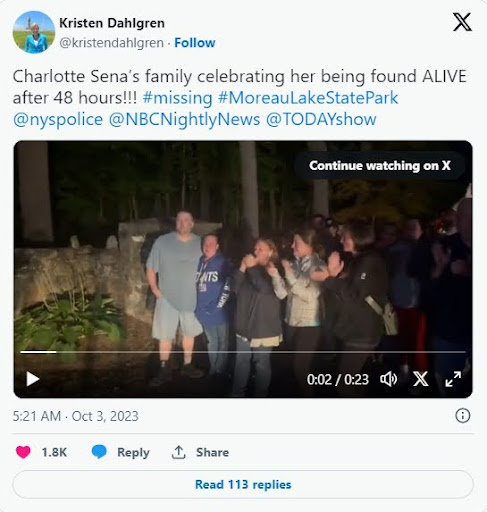BALLSTON SPA, N.Y. — In a decisive courtroom moment that captivated and relieved an anxious public, Craig N. Ross Jr., 47, was sentenced to 47 years to life in prison for the kidnapping and brutal sexual assault of 9-year-old Charlotte Sena. The sentencing, delivered in Saratoga County Court this Wednesday, marked the culmination of a harrowing saga that began last September at Moreau Lake State Park, located roughly 50 miles north of Albany, New York.
This intense case, which unfolded over 48 critical hours, began when Charlotte disappeared while biking on a trail within the state park during a family camping trip. Her sudden disappearance triggered a vast law enforcement response, characterized by frantic searches and the collective efforts of hundreds of officers, search and rescue teams, and community volunteers desperate to locate the young girl.
The critical break in the case came with the discovery of a ransom note, left in the Sena family’s mailbox; a fingerprint on the note led authorities directly to Ross. The arrest and subsequent charges brought a complex mix of relief and profound distress to the community, serving as a stark reminder of the vulnerabilities in even the most serene settings.
Ross’s conviction brings a significant measure of closure to this disturbing case, reflecting the diligent efforts of the Saratoga County District Attorney’s office and all involved law enforcement agencies to secure justice for Charlotte and ensure the safety of the community.
The Mystery Of Disappearance
Charlotte’s ordeal unfolded on a tranquil Saturday evening at Moreau Lake State Park, approximately 50 miles north of Albany. The park, known for its picturesque landscapes and tranquil environs, was the last place her parents thought peril could befall their daughter. Charlotte was there enjoying a weekend camping trip with her family, a getaway to the great outdoors meant to be filled with joy and relaxation.
The initial hours of that fateful evening painted a picture of childhood bliss as Charlotte, energetic and full of life, pedaled her bike around the park’s looping trails. Accompanied earlier by friends and family on these scenic rides, she ventured for one last solo loop before dinner. It was during this short interval that the unimaginable happened—Charlotte vanished without a trace.
The moment her absence was noted, the serene backdrop of Moreau Lake transformed into the epicenter of an urgent and massive search operation. Authorities were alerted immediately, triggering a swift response from local law enforcement. The search rapidly expanded with over 100 volunteers, drones, and search dogs combing the dense underbrush and vast expanses of the park in a desperate bid to find Charlotte.
Every passing minute was agonizing for Charlotte’s family and the growing number of concerned citizens gathered at the park. The community’s heartache was palpable, a collective dread settling in as the sun dipped below the horizon, and the park’s rustic trails grew dark and ominous. The search teams worked tirelessly through the night, their lights piercing the darkness, all hoping for a sign of Charlotte in the vast wilderness of Moreau Lake State Park. The ordeal, beginning as a peaceful family outing, had escalated into a nightmarish vigil, with everyone praying for the girl’s safe return.
Discovery Of The Ransom Note
The pivotal moment in Charlotte’s search unfolded with the unexpected discovery of a ransom note nestled within her family’s mailbox. It was a haunting message that pierced the veil of uncertainty, providing a faint glimmer of hope amidst the overwhelming dread. The note, a brazen and reckless move by the abductor, unwittingly left behind a trail of evidence that would ultimately seal his fate.
In the predawn hours, around 4:20 AM, the sinister missive was deposited, a chilling reminder of Charlotte’s perilous predicament. Little did the perpetrator realize that this impulsive act would become his undoing. Within the folds of the note lay a crucial clue—a fingerprint—a tiny mark of identity that would unlock the door to justice.
Governor Kathy Hochul, in a somber press conference, revealed the significance of this discovery. The fingerprint, meticulously analyzed, bore an uncanny resemblance to those recorded from a past DUI incident involving Ross dating back to 1999. This revelation electrified the investigation, propelling law enforcement one step closer to the elusive abductor’s whereabouts.
The fingerprint, a silent witness to Ross’s past transgressions, now emerged as a beacon of justice, guiding authorities to the heart of darkness where Charlotte was held captive. It was a moment of triumph in the face of adversity, a testament to the tenacity and unwavering resolve of those committed to bringing Charlotte home.

The joy was palpable in the air as her family gathered around, their faces alight with smiles that reached their eyes. It was a celebration of life, of survival, of the sheer force of will that had kept her tethered to this world when it seemed she might slip away. Each laugh, each hug, each shared memory was a testament to their collective relief and happiness, a chorus of gratitude that she was here, alive, and surrounded by love.
Rescue And Arrest
The culmination of Charlotte’s harrowing ordeal unfolded in a heart-stopping raid led by state police, FBI, and SWAT teams at the derelict camper where Ross had taken refuge. The scene was straight out of a high-stakes thriller, with law enforcement descending upon the decrepit camper like avenging angels, determined to rescue the young girl from her captor’s clutches.
The operation unfolded with precision and swiftness, as officers executed a dynamic entry, their presence announced by the deafening blast of flash bangs. These disorienting devices served to momentarily stun Ross, creating a crucial window of opportunity for the officers to breach the camper’s defenses.
In the tense moments that followed, law enforcement conducted a thorough sweep of the camper, their senses heightened, and their resolve unyielding. It was during this meticulous search that the miraculous discovery was made—Charlotte, hidden within a cupboard, emerged unscathed from her 48-hour ordeal.
Despite the grim circumstances of her disappearance and captivity, Charlotte exhibited remarkable resilience and fortitude. Her physical well-being defied the odds, a testament to her indomitable spirit and the unwavering dedication of those who tirelessly worked to bring her home.
The arrest of Ross, in the wake of Charlotte’s rescue, brought a sense of closure to the community and justice for the innocent victim. It was a moment of triumph for law enforcement, a reaffirmation of their commitment to protecting the most vulnerable among us, and a beacon of hope in the face of darkness.

Legal Proceedings And Sentencing
In court, Ross faced the gravity of his crimes, shackled, showing little emotion as the charges were read. He was convicted on counts of first-degree kidnapping and predatory sexual assault against a child. The judge, James A. Murphy III, handed down a concurrent sentence of 47 years to life, emphasizing the severity and premeditated nature of Ross’s actions.
During the sentencing, emotional impact statements from Charlotte’s family painted a vivid portrait of the trauma and resilience intertwined in this case. “What kind of monster does that?” questioned Charlotte’s uncle in a tense courtroom moment, demanding Ross to face him, which Ross did only briefly, his gaze falling away under the weight of his guilt.
Charlotte, who was not present in the courtroom, expressed through a statement that the nightmare did not end with her rescue; the shadows lingered in her nights. Yet, her words and her spirit, as conveyed by Saratoga County Assistant District Attorney Jennifer L. Buckley, reflected a young girl’s fierce resolve to recover and reclaim her life from her captor’s grasp.
Her mother, Trisha Sena, reframed the narrative in her statement to the court and to the media, emphasizing, “Please do not call her a victim. She is a survivor.” This sentiment was echoed throughout the community, praising Charlotte’s courage and the meticulous efforts of the law enforcement agencies involved.
The success of this case was a testament to the collaboration across various law enforcement levels including local police, state troopers, and national agencies like the FBI and the U.S. Marshals. The governor praised this concerted effort which involved over 400 search and rescue personnel combing through 46 linear miles and highlighted the use of Amber Alerts and public vigilance in such critical missions.
The local and national reaction was one of relief mixed with profound indignation at the heinous nature of the crime. Videos circulated on social media showed the moment Charlotte’s family received the news of her safe recovery; cheers and tears painted a scene of communal catharsis.
Charlotte’s aunt, Jene Sena, noted the surreal rapidity of the girl’s disappearance, describing it as vanishing “almost into thin air.” It was a chilling reminder of the vulnerability and the persistent threat lurking in public spaces, which this case has brought to the forefront.
This sentencing also brings to light broader questions about safety in public parks and the effectiveness of current protocols to prevent such incidents. As Charlotte’s case concludes with her abductor behind bars, it provides a grim reflection and a crucial learning point for enhancing child safety measures and public awareness campaigns.
The case of Charlotte Sena will undoubtedly serve as a harrowing yet hopeful chapter in the annals of criminal justice in New York. The swift action, driven by decisive evidence and collaborative law enforcement efforts, led to a resolution that, while not undoing the trauma experienced, has delivered justice robustly. Charlotte’s ordeal and subsequent bravery will resonate as a powerful testament to the spirit of survival and the relentless pursuit of justice by the community and the guardians of law and order.
As Charlotte continues her journey of healing, supported by her family and community, the echoes of her ordeal remind us of the fragility of safety and the imperative of vigilance. Ross’s sentencing not only marks the end of a traumatic saga but reinforces the legal and moral fabric that holds potential predators accountable and safeguards our children’s innocence and freedom.







